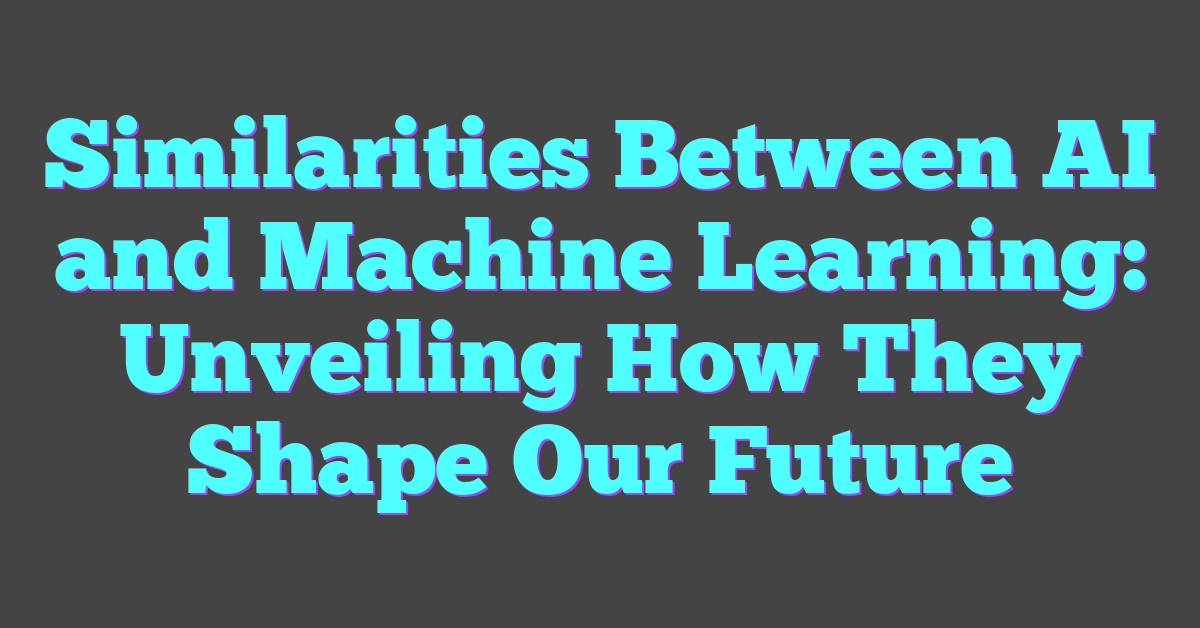Artificial Intelligence (AI) and Machine Learning (ML) often get tossed around in conversations about technology, but many don’t realize how intertwined they are. Both fields aim to create systems that can perform tasks typically requiring human intelligence, like recognizing speech or making decisions. Though they have distinct definitions, their overlap is significant and fascinating.
At their core, AI and ML share the common goal of enabling machines to learn from data and improve over time. They both utilize algorithms to process information and identify patterns, which can lead to smarter, more efficient systems. Understanding these similarities can demystify the tech world and highlight the exciting potential these technologies hold for the future.
Exploring the Roots: Understanding AI and Machine Learning
The intertwined relationship between AI and machine learning fascinates many. Each serves different roles, yet together they form the backbone of intelligent systems.

The Definition of Artificial Intelligence
Artificial Intelligence (AI) refers to the simulation of human intelligence in machines. These machines perform tasks such as problem-solving, learning, and decision-making. AI systems utilize various methods, including reasoning and perception, to mimic human cognitive functions. Examples include natural language processing, robotics, and computer vision.
What Is Machine Learning?
Machine Learning (ML) is a subset of AI that focuses on data-driven learning. ML algorithms enable computers to learn from data patterns without explicit programming. By analyzing large datasets, these algorithms build predictive models to perform tasks such as classification, regression, and clustering. Examples include recommendation systems, speech recognition, and autonomous vehicles.
Core Similarities Between AI and Machine Immigration
AI and ML share foundational elements that drive their development and applications, making them powerful tools in the tech landscape.
Data Dependency
Both AI and ML heavily rely on data. They use large datasets to recognize patterns and generate insights. In AI, data serves as the foundation for creating intelligent systems capable of complex tasks. Conversely, ML algorithms, such as decision trees and neural networks, require high-quality data to train models effectively. Successful AI and ML implementations have vast, relevant datasets.
Learning and Adaptation Capabilities
AI and ML excel in learning and adapting. They evolve by processing data, identifying patterns, and improving over time. AI systems, such as chatbots and recommendation engines, adapt based on user interactions. ML models, like supervised learning and reinforcement learning, enhance their predictions and decisions through continuous iterations. Both technologies aim to achieve high accuracy and adaptability in dynamic environments by leveraging learning and adaptation capabilities.
Practical Applications of AI and Machine Learning
AI and ML transform industries with innovative solutions, enhancing efficiency and capabilities across various sectors.
Innovations in Healthcare
AI and ML revolutionize healthcare by improving diagnostics, patient care, and operational efficiency. AI-driven medical imaging accurately detects early signs of diseases like cancer, reducing human error. Machine Learning algorithms, trained on vast datasets, predict patient outcomes, enabling personalized treatment plans. Virtual health assistants, powered by AI, provide 24/7 support, answering patient queries and monitoring chronic conditions. Additionally, AI optimizes administrative processes, reducing workload and streamlining tasks like scheduling and billing.
Advances in Autonomous Vehicles
Autonomous vehicles leverage AI and ML to navigate complex environments safely. Machine Learning models process real-time sensor data, enabling cars to recognize objects, predict movements, and make driving decisions. AI algorithms improve with each interaction, learning from diverse scenarios to enhance performance. This technology not only enhances vehicle safety by reducing human error but also holds the potential to revolutionize transportation logistics, lowering costs and improving efficiency. Major automotive companies and startups invest heavily in autonomous vehicle R&D, showcasing the significant impact of AI and ML in this field.
Ethical Considerations and Future Implications
AI and Machine Learning hold tremendous potential, but ethical considerations and future implications must be carefully addressed to ensure responsible development.
Ethical Issues in AI and ML
Ethical issues in AI and ML arise from their broad applications. Data privacy and security are major concerns; these technologies often require vast amounts of sensitive data. For instance, AI-powered medical systems analyze patient data to aid diagnosis, raising questions about data protection. Bias in AI algorithms is another significant issue. AI systems trained on biased data can lead to unfair outcomes, perpetuating existing inequalities. Discriminatory algorithms in hiring processes or law enforcement exemplify this challenge.
Transparency and accountability in AI systems are essential. Users should understand how decisions are made, especially in critical areas like finance or healthcare. Lack of transparency can erode trust, making it crucial for developers to provide clear explanations of AI decision-making processes.
The Future of AI and ML Technology
The future of AI and ML technology promises advancements but brings challenges. AI’s role in autonomous systems, like self-driving cars, will expand, requiring robust safety regulations. Machine learning will continue transforming industries through predictive analytics and automation, enhancing efficiency and innovation.
Continued research and development in AI ethics are vital. Establishing ethical guidelines and standards will ensure AI benefits society responsibly. Collaboration between governments, industries, and academia will be key in shaping the ethical landscape of AI and ML, fostering technology that respects user rights and promotes equitable outcomes.
Conclusion
AI and ML continue to transform our world in remarkable ways. Their shared capabilities in pattern recognition and data-driven insights are reshaping industries and everyday life. Ethical considerations and future implications are crucial as these technologies advance. Ensuring transparency accountability and robust safety measures will be key to their responsible development. By fostering collaboration among governments industries and academia society can harness the full potential of AI and ML while mitigating risks. The journey of AI and ML is just beginning and with thoughtful guidance it promises a future filled with innovation and positive impact.
Frequently Asked Questions
What is the relationship between AI and ML?
Artificial Intelligence (AI) involves creating systems that simulate human intelligence, while Machine Learning (ML) is a subset of AI that focuses on enabling machines to learn from data and improve over time. ML is a method used within AI.
How are AI and ML revolutionizing industries?
AI and ML are transforming industries such as healthcare, by improving diagnostics and personalized treatments, and transportation, by enhancing autonomous vehicle technology and optimizing logistics.
What ethical concerns arise with AI and ML?
Key ethical concerns include data privacy, bias in algorithms, and the need for transparency and accountability in AI-powered decision-making.
Why is data privacy important in AI and ML?
Data privacy is crucial because AI and ML systems often rely on large amounts of personal data. Protecting this data ensures individuals’ rights and prevents misuse or unauthorized access.
How can bias in AI algorithms be addressed?
Bias can be mitigated by ensuring diverse data sets, regular audits, and implementing fairness-aware algorithms to provide equitable outcomes.
What future implications do AI and ML have?
The future of AI and ML includes the need for robust safety regulations, ethical guidelines, and collaborative efforts among governments, industries, and academia to ensure responsible use.
Why is transparency important in AI decision-making?
Transparency allows users to understand how decisions are made, building trust and ensuring accountability, especially in critical areas like healthcare and law enforcement.
How can we ensure responsible use of AI and ML technologies?
Responsible use can be ensured through international collaboration, ethical guidelines, continuous monitoring, and adherence to safety regulations in the development and deployment of AI systems.
What role do governments play in AI and ML regulation?
Governments play a crucial role by creating and enforcing laws and regulations that ensure AI and ML technologies are developed and used ethically and safely.
Why is collaboration important in the development of AI and ML?
Collaboration among governments, industries, and academia fosters innovation, ensures diverse perspectives, and promotes the development of comprehensive ethical and safety standards.




